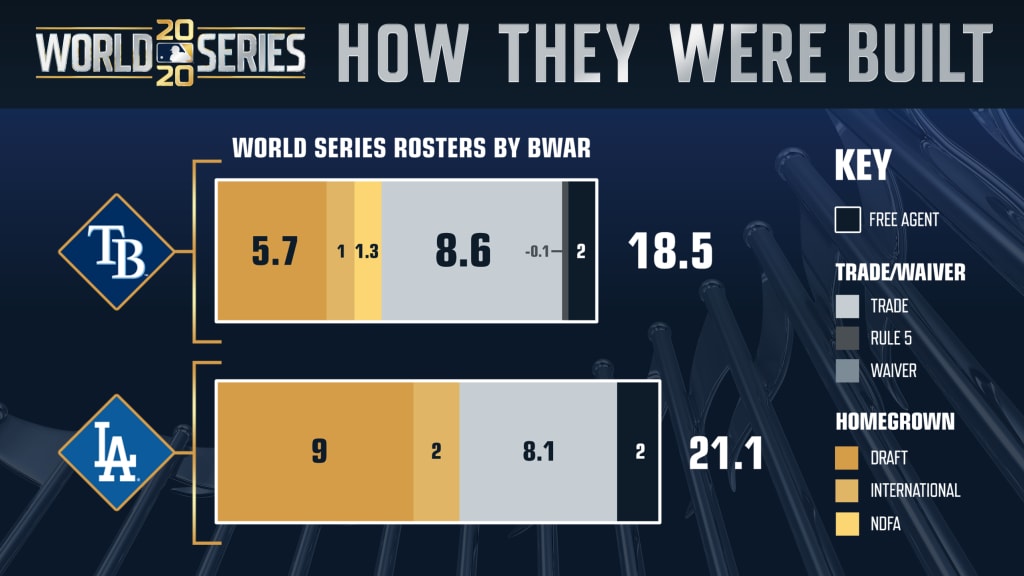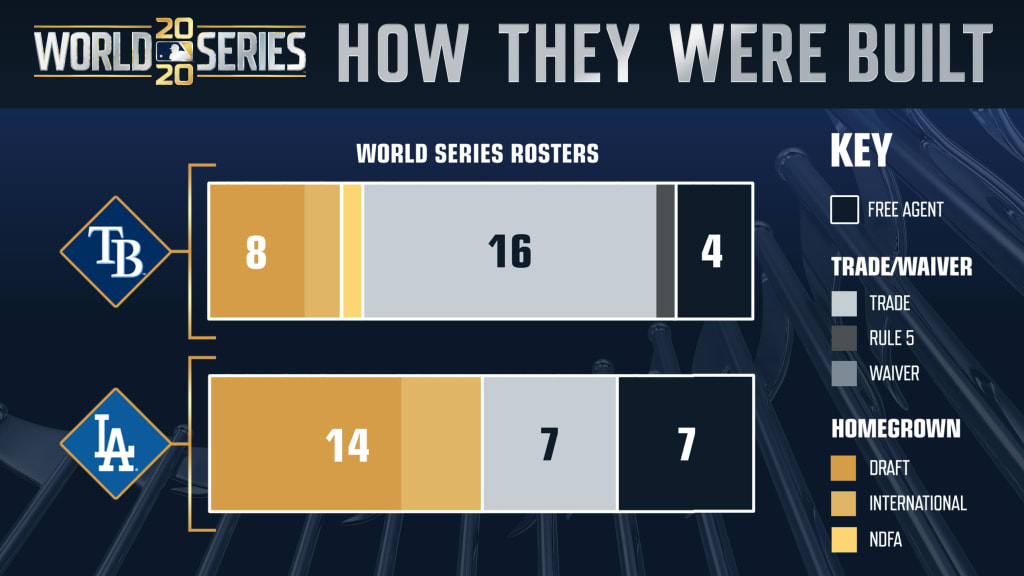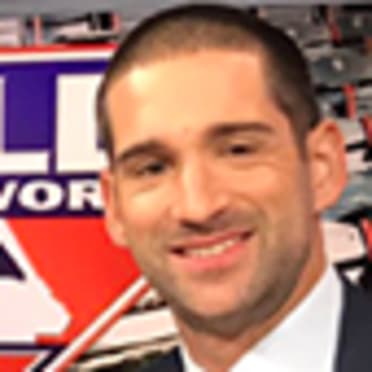
The teams with the best regular-season record in each league this year are set to meet in the World Series, with Game 1 between the Dodgers and Rays scheduled for Tuesday, Oct. 20 at 8:09 p.m. ET at Globe Life Field in Arlington.
As the reigning seven-time NL West champions, the Dodgers entered 2020 poised to take home an eighth straight division title, especially after the club¡¯s offseason acquisition of Mookie Betts from Boston. They ultimately recorded baseball¡¯s best record (43-17) during the 60-game regular season before sweeping Milwaukee and San Diego in the Wild Card and Division Series to reach the NLCS, where they rallied from a 3-1 series deficit to defeat the Braves in seven games to reach the World Series for the third time in four years.
The Rays, on the other hand, are making their second World Series appearance in franchise history and first since they lost to the Phillies in five games in 2008. They edged the Astros in Game 7 of the ALCS, after relinquishing a 3-0 series lead, to reach the Fall Classic, following wins against the Blue Jays and Yankees in the Wild Card and Division Series, respectively. They ran away with the American League East title this year, spending the final 44 days of the regular season in first place en route to a 40-20 record.
But while the two organizations occupied opposite ends of the payroll spectrum this season, both league champions took a similar approach to constructing their pennant-winning teams, developing key homegrown players (amateurs drafted or signed by the organization) while also bolstering their rosters through trades and free-agent signings.

There are, however, some notable differences between the two World Series rosters.
The Dodgers, with homegrown players comprising half of their World Series roster, have fared far better in the Draft than Tampa Bay, hitting big on first-round picks Clayton Kershaw (2006), NLCS MVP Corey Seager (2012), Walker Buehler (2015) and Will Smith (2016). They also have done better with later-round selections, getting Cody Bellinger (2013), Dustin May (2016) and Edwin R¨ªos (2015) in rounds 3-6 as well as Tony Gonsolin (2016) and Joc Pederson (2010) in the ninth round or later.
The Rays¡¯ contingent of homegrown talent is headlined by 2018 AL Cy Young Award winner Blake Snell, a supplemental first-round pick in ¡¯11, and fellow southpaw Shane McClanahan, who made his big league debut against New York in the ALDS a little more than two years after the Rays selected him with the No. 31 overall pick. Third-rounder Brandon Lowe (2015) and Kevin Kiermaier, a 31st-round pick in ¡¯10, both ranked among the top three on the Rays in WAR during the regular season, and 2017 fifth-rounder Josh Fleming also finished in the top 10.
The impact of both teams¡¯ international efforts can be seen in the composition of their respective postseason bullpens. Each of the Dodgers¡¯ four international signees have pitched well en route to the Fall Classic, with Kenley Janson, Pedro B¨¢ez, Julio Ur¨ªas and Victor Gonz¨¢lez all working high-leverage spots in relief. The Rays¡¯ pen features flame-throwing international signee Diego Castillo, who saved two games in the ALCS.
Mike Brosseau, a non-drafted free agent signed by the Rays in June 2016, captured the national spotlight with his series-winning home run off the Yankees¡¯ Aroldis Chapman in Game 5 of the ALDS. He finished fourth on the club in WAR during the regular season and provides the Rays with defensive flexibility and a sound right-handed bat. Yoshi Tsutsugo, who signed a two-year, $12 million pact in December, offers some left-handed pop off the bench following an eight-homer rookie campaign.
Not only do players acquired via trade/Rule 5 comprise 16 of 28 spots on the Rays¡¯ WS roster ¨C they had the highest total of the four teams to reach the Championship Series ¨C but many have emerged as highly valuable, impact players after joining the organization early on in their professional careers.
Trading David Price to Detroit in July 2014 netted the Rays a long-term shortstop in Willy Adames, a 7.5-WAR player across his first three seasons, while Tyler Glasnow and Austin Meadows have quickly developed into star-caliber players after being acquired from Pittsburgh in the lopsided Chris Archer Deadline deal in ¡¯18. Bringing in Hunter Renfroe, Manuel Margot and ALCS MVP Randy Arozarena through separate offseason trades helped fortify the Rays¡¯ outfield this year, while the decision to trade from a point of depth (OF Jes¨²s S¨¢nchez, RHP Ryne Stanek) to get righty Nick Anderson from Miami at last year¡¯s Deadline gave the Rays arguably baseball¡¯s best reliever during the regular season.
What¡¯s more, the Rays¡¯ ability to find value in smaller deals cannot be understated. The club has acquired numerous hitters in such deals since the end of the 2017 season, getting bats like Joey Wendle (A¡¯s), Mike Zunino (Mariners), Yandy D¨ªaz (Indians) and Ji-Man Choi (Brewers). Ryan Yarbrough, whose 1.2 WAR led all Rays hurlers during the regular season, was a big get for Tampa Bay in the January 2017 deal that sent Drew Smyly to Seattle, and Pete Fairbanks, acquired from Texas in a one-for-one prospect swap for Nick Solak, has the look of a long-term bullpen asset for the organization.
The Dodgers¡¯ Division Series roster this year featured fewer acquired players (7) than any of the eight teams which advanced past the Wild Card round. However, no player acquired via trade helped his team in 2020 quite like Betts, who led the National League in WAR (3.4 WAR) after the Dodgers acquired him and Price from Boston during the offseason. Yes, the Dodgers were forced to part with some good homegrown talent in the deal, trading away Alex Verdugo as well as prospects Jeter Downs and Connor Wong, but the organization¡¯s overall depth had made all three players expendable. The Betts trade also got the Dodgers power-armed reliever Brusdar Graterol, a cost-controlled asset who lit up the radar gun while making 23 appearances as a rookie.
Similar to the Rays, Los Angeles has made several small moves that have turned into steals, such as dealing for Enrique Hern¨¢ndez (a throw-in in the Dee Gordon trade with the Marlins in 2014) and Chris Taylor (from the Mariners for Zach Lee in 2016) and signing lightly regarded free agents Justin Turner ($1 million Minor League deal in 2014) and Max Muncy (released by Athletics in 2017).
Of course, Tampa Bay knows a thing or two about finding value in under-the-radar free agents. Right-hander John Curtiss and lefty Aaron Loup, both signed by Tampa Bay last February, combined for 1.3 WAR during the regular season while appearing in 41 games. Charlie Morton, pitching in the second year of his two-year, $30 million deal, is the only other free agent on Tampa Bay¡¯s World Series roster. The 36-year-old right-hander was brilliant vs. Houston in the ALCS, winning Games 2 and 7 and working 10 2/3 scoreless frames between the two outings.
Outfielder AJ Pollock, who clubbed 16 home runs in 55 games in the second of his four-year, $55 million deal, headlines the Dodgers¡¯ crop of free agent signings. Relievers Joe Kelly (3 years, $25 million through 2021), Jake McGee (3 years, $27 million through ¡®20), Blake Treinen (1 year, $10 million) and Alex Wood (1 year, $4 million) round out the rest of that group.
It¡¯s worth noting that each of the past three World Series champions (Astros, Red Sox and Nationals) have won using a similar blueprint, developing quality hitters as well as some pitching while importing impact-caliber talent to help address any roster deficiencies.
That blueprint will have worked for a fourth straight season if the Dodgers are able to defeat Tampa Bay and win their first World Series title since 1988. But should the Rays ultimately take down the Dodgers in this year¡¯s Fall Classic, despite their acquisition-heavy postseason roster and longstanding payroll limitations, baseball may very well see more teams try to adopt that successful model in 2021 and beyond.

